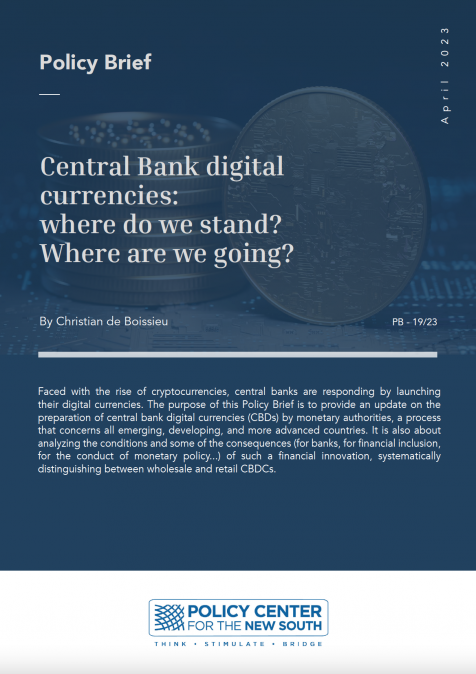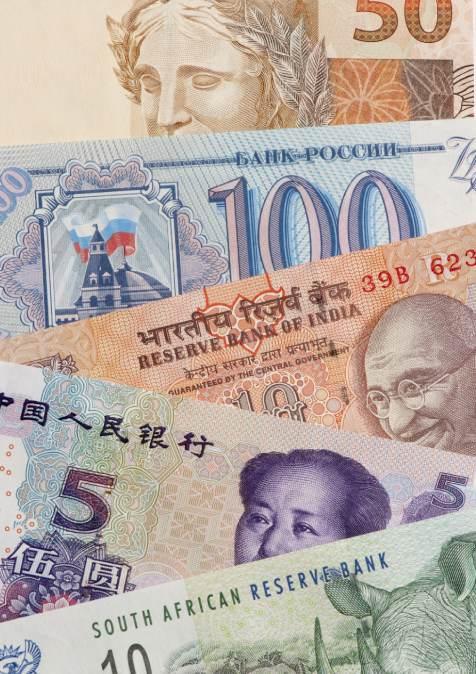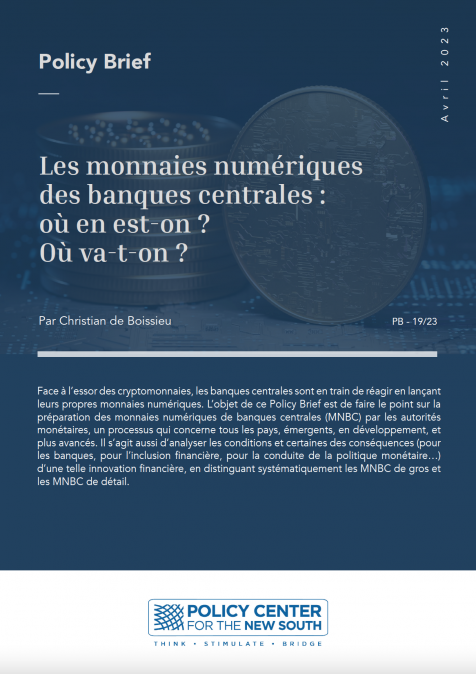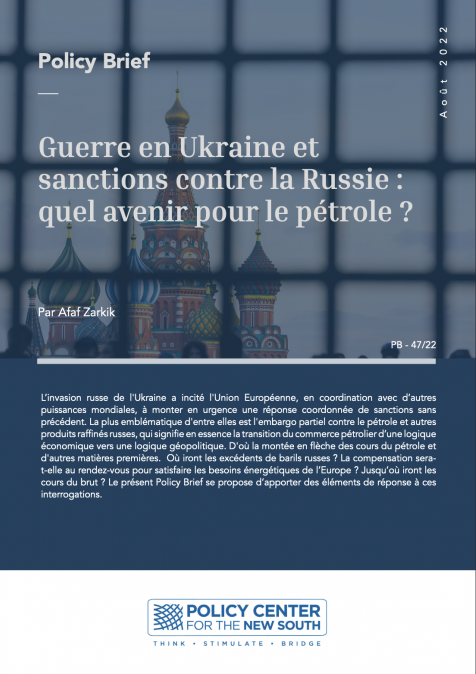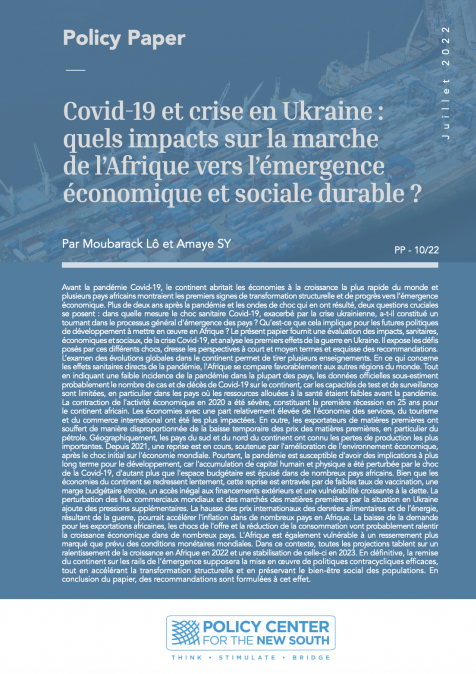Publications /
Policy Brief
Faced with the rise of cryptocurrencies, central banks are responding by launching their digital currencies. The purpose of this Policy Brief is to provide an update on the preparation of central bank digital currencies (CBDs) by monetary authorities, a process that concerns all emerging, developing, and more advanced countries. It is also about analyzing the conditions and some of the consequences (for banks, for financial inclusion, for the conduct of monetary policy...) of such a financial innovation, systematically distinguishing between wholesale and retail CBDCs.
INTRODUCTION
Since the 2008 founding paper by S. Nakamoto (a pseudonym that probably disguises a collective of authors...), which introduced blockchain technology and bitcoin simultaneously, cryptocurrencies have developed rapidly. These are digital and decentralized monetary assets because they are born from initiatives coming not from monetary authorities but from private agents. This is why, in short, we can speak of private currencies in contrast to public or official currencies (so-called "fiat" currencies). The reference to private currencies requires clarification. For central bankers often refer to the money created and managed by second-tier banks as private money, in contrast to central bank money. Whether official money, endowed with legal tender and liberatory power, is housed in the balance sheet of the central bank or in the balance sheets of the banks does not change its public and "fiat" dimension. Cryptocurrencies are truly private currencies for the reasons mentioned above.
But, with crypto-currencies, are they currencies in the full sense of the word? To answer this question, the distinction made long ago by John Hicks, Nobel Prize winner in economics, between complete and partial money is enlightening. A currency is complete if it fulfills the three traditional functions of money: unit of account, an intermediary between exchanges (or transactional function of money), and reserve of value. A partial currency satisfies at most two of the three usual functions of money.
It must be recognized that, so far, bitcoin and other cryptocurrencies remain partial currencies. They only marginally fulfill the specific function of money, the transactional function. Only two countries have granted legal tender to Bitcoin: El Salvador since December 2021 (where it circulates alongside the U.S. dollar), and the Central African Republic, which accepts the parallel circulation of Bitcoin and the CFA franc. The empirical volatility of crypto-currencies makes them poor units of account and inferior standards of value. It is this empirical volatility that has led Salvadorans to shun bitcoin in favor of the dollar for their current settlements. For crypto-currencies, the excess volatility is likely to be reduced regarding "stablecoins" anchored to a public currency with an, in principle, fixed parity. But even then, some "stablecoins" have proven to be highly unstable over the past two-three years, with trading platforms unable to cope with impromptu and massive withdrawals of liquidity by investors. This is another illustration of the fact that the coexistence of several currencies on the same territory is rarely peaceful: one of them ends up prevailing over the others according to individual preferences.
Because cryptocurrencies remain today partial currencies in the sense of Hicks, central bankers prefer to call them crypto-assets, a way of considering them as an asset class. This semantic distinction is substantial, not formal. Despite this, and for the sake of simplicity, I will continue to talk about cryptocurrencies in this paper.
To the extent that crypto-currencies are private and decentralized, they pose a challenge, if not a threat, to central banks and the monetary policy they conduct. This is because they infringe on the monetary power of governments, on the regulation of payments and the money supply by central banks, on the prerogatives of banking and financial regulators... For example, on this last point, they can sometimes be used to circumvent regulations concerning the fight against money laundering and the financing of terrorism. Because cryptocurrencies are private, they are not backed by any central bank or any "lender of last resort" if their prices were to devaluate..It is therefore, understandable why, faced with these new challenges, central banks wanted to regain control.
Faced with the rise and multiplication of crypto-currencies, central banks, with the blessing of governments, have reacted by announcing the launch of central bank currencies, therefore public, digital. It must be said that such a reaction was catalyzed by the initiative of Facebook/Meta to market a cryptocurrency first named Libra and then named Diem. A variety of "stablecoin" anchored on the dollar, the Diem, if it had seen the light of day, would have potentially concerned nearly two and a half billion individuals, all Facebook users. An elephant in a China store, the door is open to a real threat to the monetary sovereignty of States and their central banks. This case gave rise to a tug-of-war between Facebook and the American and European authorities. It was a real test of the latter's ability to oppose a major monetary initiative by one of the GAFAMs (Google, Apple, Facebook, Amazon, Microsoft). Everyone is on board, the Fed, the ECB, the G20...to nip Diem in the bud. Game over? We'll see. The authorities' response consisted of a regulatory block on Facebook's project; it mainly led to the central bank digital currencies projects. Since blockchain, artificial intelligence, and metaverse technology is here, why not apply it to the backbone of any monetary and financial system, the central bank currency? The latter is made up of banknotes and coins in circulation as well as banks' reserves at the central bank, to which the money is added created by the banks through the credits they grant and the deposits they collect, according to the canonical formula, "credits make deposits". The latter is made up of banknotes and coins in circulation and of the banks' reserves at the central bank, which are backed by the money created by the banks through the loans they grant and the deposits they collect, according to the canonical formula, "loans make deposits". The distribution of credit generates the creation of money by banks in the form of deposits, which some people call "private" money, as opposed to public money, which is central bank money. We have already stated that we, for our part, prefer to reserve the name of private currencies for crypto-currencies...CBDC, like crypto-currencies, has no physical existence. It must be recorded in a ledger, part of the blockchain (distributed ledger technology). It represents a claim for those who will hold it, a debt for the central bank. As a result, it will appear as a liability on the company's balance sheet.
THE STATE OF THE ART OF CBDC
In order to measure the phenomenon, it is necessary to distinguish between two separate but often complementary components:
1/ Retail CBDCs, which are intended to be accessible to everyone for everyday payments. 2/ Wholesale CBDCs will concern interbank relations (for example, via the money market).
According to BIS statistics, as of the end of 2022, nearly 90% of the world's central banks had begun to consider, and in some cases had even taken the first steps toward, launching an NBM. Either by adopting a global approach combining wholesale and retail CBDC from the outset or by favouring a sequential approach, generally starting with wholesale CBDC. This sequential approach starting logically enough with the wholesale CBDC is, among many identical examples, that of the Bank of Algeria.
All countries, including emerging and developing countries, struggling to emerge, are concerned about launching their CBDCs. China was historically the first to work on its CBDC, followed closely in time by Sweden. Very reluctant and even very constrained by the rise of bitcoin and other private digital currencies, it took the lead in the face of private and decentralized initiatives by launching the e-yuan before anyone else. A paradox since the yuan is still not fully convertible. Probably not: the Chinese are playing the game of parallelism between technological innovation and external openness, between the development of digital public money and the promotion of the yuan's international role. Moreover, in a hypercentralized system, the digital yuan will reinforce the means of control by the state apparatus rather than giving private operators possible degrees of freedom.
LThe United States has come to the issue of CBDC recently, with the release in September 2022 of a Report commissioned by the White House.1 A signal that, on the American side, the subject is being tackled at a higher level with the future of the dollar's pre-eminence on the world stage at stake. However, there are differences between the Fed and the Treasury on the American side. The central bank is taking a back seat on the e-dollar project, as so far, it is satisfied with the existence of two stablecoins pegged to the dollar, the Tether (USDT) and the USD Coin (USDC). Unlike other examples of stablecoins, these are truly "stable" cryptos, backed by platforms that can cope with sudden withdrawals of cash. The Fed, watching these two cryptos like clockwork, considers them pretty good "proxies" for an e-dollar that doesn't yet exist. This is, in any case, the position expressed on several occasions by Fed Chairman Powell. The U.S. Treasury is more aggressive on the subject, especially for a "wholesale" e-dollar used in interbank relations. He is probably more sensitive to national monetary sovereignty considerations and the dollar's international role. The approach and positions of each of the authorities concerned are political before technical. Does such a political dimension violate the sacrosanct principle of central bank independence? Not necessarily...
Following rather than leading the way of digital public money is not necessarily a handicap.in some cases, it allows the "followers" to benefit from the experience of the leaders to avoid making certain mistakes. To stick to the eurozone, the ECB has opened an investigation phase on the digital euro in mid-2021, involving the entire Eurosystem (in addition to itself, the central banks of the euro zone member countries). This phase, which will focus on retail payments (households and small businesses) and then extend to wholesale payments (especially interbank transactions), will last until the fall of 2023. From there, the idea is to launch the retail digital euro quickly, at least faster than initially envisaged. In the meantime, it is important to educate public opinion, consumers, and companies, as well as public administrations. It is also necessary to verify the compatibility of the technologies used for the digital euro with those implemented in existing payment systems. Isn't nearly five years to launch digital too long, given the availability of the required technologies? These technologies are themselves quickly overtaken by new ones, which implies being pragmatic. In practice, the transitions to be made will take time and will change certain payment habits, even if the digitization of the euro will require far fewer adjustments than the changeover from national currencies to the euro did at the time.
The European experimentation phase has already caused controversy. Following a call for tenders soliciting private companies to prepare prototypes, the results of which were unveiled in September 2022, the ECB selected five companies out of 54 candidates, including the French company Worldline and the American company Amazon. The horse in Troy? This introduction of one of the GAFAMs into the heart of the European monetary reactor has, not surprisingly, caused some commotion. In response, the ECB emphasized that the prototypes tested during the experimental phase did not prefigured the solution finally adopted. It is more convincing!
The density of mobile telephony is not only a consequence of introducing new technologies but also a response to challenges common to many African countries. Africa does not lag advanced countries in this area, far from it. In terms of electronic payments and the digitalization of payments, the African continent is even ahead of certain Northern countries. introducing butBy skipping the check stage, African countries have more than made up for the delay they had in electronic payments ten years ago. According to figures given by Cina Lawson, Togo's Minister of Digital Economy and Digital Transformation, the mobile penetration rate in her country has increased from 41% in 2011 to 78% in 2021. A similar trend is observed in all African countries.
African officials expect at least three positive effects from the CBDC: 1/ to counter cryptocurrencies' influence, often considered excessive. For example, the Central Bank of Nigeria is very insistent on this objective; 2/more financial inclusion, in countries where 50% of the population is often unbanked. In the CFA franc zone, in 2022, 52% of the population did not have a bank account; 3/ a stimulus for international currency transfers, thanks to the reduction in the time required for such transfers and the lower transaction costs involved. On the continent, Nigeria and Ghana are the most advanced in launching the e-naira and e-celi, respectively. Morocco has set up a committee to assess the costs and benefits of a CBM from 2021. Egypt launched a study in 2022 for the e-EGP. An identical approach is adopted by the BCEAO and BEAC. On CBDC, African countries are converging, with little time lag, towards a cautious, gradual, and pragmatic approach. In doing so, they are in line with a widely shared problem in the world.
WHY CBDC EXISTS
A variety of arguments are made in favor of CBMs. The list of benefits should not obscure some of the costs of the operation. Just as the production (the "mining") of cryptocurrencies via blockchains requires high energy consumption and goes against widely shared ecological goals, so too does the production of CBDC, generally using blockchain technology, raises the same type of challenges. A comprehensive assessment of CBMs would involve taking stock of all the costs and benefits discounted (with what discount rate?), as they are distributed over time. At this point, in a partial approach that cannot pretend to replace an overall assessment, I will mention some of the expected benefits of CBMs. Here is a non-exhaustive list:
1) introduce new technologies in central banking and monetary policy. The argument is unstoppable because it is common sense. It is not clear why and how central bank money could stay out of this technological groundswell. Users want access to digital currencies, whether partial, like cryptos, or complete, like CBDCs, that perform all possible currency functions. This demand by non-financial agents for the latest technological innovation exists everywhere, even in developing countries, as the rise of digital money in sub-Saharan Africa suggests;
2) to preserve the central bank money as the pivot of the monetary system. As we have said, this central bank money fulfils two essential roles: it satisfies the demand of the public and of companies for cash that will, in practice, be dematerialized; it is the pivot that allows the creation of money by banks. For central banks, CBDC will be there to compensate, in an arithmetic sense, for the decline in cash. A relative decline, as a proportion of the total money supply or as a percentage of the central bank's total balance sheet, and necessarily slow given habits, cultural data.Even in advanced countries, the share of cash is resisting the decline for several reasons. Thus, at the end of 2022, banknotes in circulation still represented 20% of the Eurosystem's balance sheet. The corresponding figures are much higher in emerging and developing countries. So, even if the use of cash is resisting a little bit everywhere, central banks, with the CBDCs, anticipate in the long term not its disappearance but its relative decline.
In the minds of its promoters, the retail CBDC will have to be primarily a means of payment. But in practice, as with banknotes, there is nothing to prevent it from also serving as an investment asset, such as a medium for intense hoarding by households, companies, etc. This means that, for the policy of issuing this CBDC as for the conduct of monetary policy, the central bank will have to try to identify a demand function for retail CBDC by the public and a demand function for CBDC by financial intermediaries that is as unstable as possible. The central bank should seek to identify a demand function for retail CBDC by the public and a demand function for CBDC by financial intermediaries that are as unstable as possible over time, in a context where many factors are likely to fuel such instability (step changes in inflation rates, in interest rates, the impact of new technologies, etc.).).
The rise of cryptocurrencies has led to an undeniable fragmentation of the monetary system, as each reign, so to speak, in a restricted area of acceptance and circulation. The CBDC makes it possible to fight against such fragmentation, by conferring on the public money of central banks, thanks to digital technology, the function of recreating the unity and homogeneity that are indispensable to the proper functioning of the payment system and to the effectiveness of any monetary policy. More precisely, the homogeneity of a currency means that it is exchanged at a 1/1 parity between the different forms (cash, deposits, digital version. ) that it may take. This will mean, for example, that digital currency, whether wholesale or retail, will have to be exchanged at parity for any non-digital version of "fiat" currency in all circumstances.
3) increase the transparency, traceability, and security of payments. These are the usual benefits of new technologies that "encapsulate" relevant payment information. The concern for traceability of flows, for reasons of combating money laundering or the financing of terrorism, and for tax considerations and is likely to conflict with what is made possible by cash in the form of banknotes and coins, as a negative of CBDCs. As Dostoyevsky said, money, especially cash, is "minted freedom". Freedom reinforced by the anonymity of the regulations, the protection of data in the sense of the European RGPD regulation, For CBDCs to become accepted, central banks will have to reassure future users that these digital currencies will not be a "Big Brother"-style intrusion into everyone's life and that there will be no cross-checking between the different data sources unless there is a supposed or proven regulatory or fiscal breach;
4) expand financial inclusion. The argument is often suggested, but not demonstrated. Only experience will show whether CBDCs have indeed been able to attract to the formalized and regulated financial system segments of the population that were either deprived of access to financial services and formal payment and settlement mechanisms or were confined to the informal economy and finance.On ly experience will show whether CBDCs have indeed attracted to the formalized and regulated financial system segments of the population that were either deprived of any access to financial services and formal payment and settlement mechanisms, or were confined to the informal economy and finance. Let's be clear: CBDC will not, by itself, correct income, or wealth inequality or address the lack of financial information and education. But, working on the example of Indonesia, a country in which only 7 million out of nearly 280 million inhabitants invest in the stock market, N.Bilotta2 shows that a digital rupiah would facilitate financial inclusion by reducing transaction costs, for example, on the capital of Indonesian emigrants transferred to their country of origin, by reducing the costs of identification, and by reducing the costs of the financial system.This would be achieved by reducing transaction costs, for example, on the capital of Indonesian emigrants transferred to their home country, by lowering identification costs (compared to bank intermediation costs) for those wishing to make payments and settlements, and by facilitating financial education.
Here again, Africa's experience can help make projections for the rest of the world. On the African continent, private digital money, despite its "technocratic" dimension, has not increased the social divide; it has promoted financial inclusion, including in rural areas. To be followed closely to see if the case of Africa is generalizable;
5) reduce transaction costs. In this area, private and public digital currencies are in line with each other. Thanks to the protocols involved, the volumes exchanged and the economies of scale, both systems drastically reduce the unit cost of payments. There is an argument favoring disintermediation, of bypassing banks, which, for many reasons, find it difficult to rapidly lower the cost of banking intermediation. In an open economy, reducing money transfer costs has obvious microeconomic benefits. It has the disadvantage of making capital outflows less costly in the event of speculation against the national currency...It is difficult to win on all fronts at once, except to pretend to avoid this disadvantage by strengthening exchange controls, which would, in turn, generate other types of costs and would be even easier to circumvent by domestic economic agents thanks to digital currencies;
6) promote the international role of the domestic currency. What would happen in practice if, for example, the Eurosystem abandoned the digital euro, while the digital dollar and the digital yuan were implemented? One can imagine that the competitiveness of the euro, i.e., its ability to compete with other reserve currencies, would be reduced, with a rapid decline in the market share of the European currency. The example of the euro example ed to other reserve currencies and to all currencies that claim to play a supranational role. Digital technology will be at the heart of the competition between currencies, with the battle for increased market share on the global or at least regional stage. This is an example of the knock-on effect of financial globalization: a country is obliged to have its CBDC if the others are leading the way, which pushes the digitization process "upwards". Some forces in the direction of a (limited) fragmentation of the world economy and finance, born of COVID-19- and the war in Ukraine, do not change the case.
SOME CONSEQUENCES OF MBCS
As mentioned, CBDCs will only be able to be deployed if they comply with personal data protection rules, for us in Europe, the RGPD regulation. The regulatory authorities will have to take great care of this. Otherwise, the credibility. And therefore, the use of these digital currencies will be undermined.
As we have seen, CBMs will be complete currencies in the sense of John Hicks since they can fulfill all the traditional functions of money. Most of the preparatory studies for the launch of CBDCs emphasize their role as units of account, which is certainly important but not exclusive of their ability to satisfy the other two functions. In this respect, they will have a competitive advantage over private cryptocurrencies, which will remain very partial currencies if they are not legal tender.
This difference in nature between full and only partial currencies will inevitably have consequences for competition between them, but also for the following question: will CBDCs add to (complementarity effect) or substitute existing currency components? The question is to be addressed in three facets:
1) CBDCs should be an addition to, rather than a substitute for, cryptocurrencies. They will be the medium of "return" operations of crypto-currencies to the "fiat" currency and the official monetary circuits without underestimating the frequency of reverse flows. It is during such return flows that the fight against money laundering and against the financing of terrorism comes into play, as well as possible tax audits;
2) Will CBDCs lead to deposit attrition at banks? In any case, this is the fear of many bankers, which concerns retail CBDC, potentially affecting the entire population. In concrete terms, banks fear that in times of stress, and even more so in the face of a systemic banking crisis, customers will convert their bank deposits into CBDCs, through a phenomenon of transferring them to the "good" money. For the wholesale CBDC, there is no fear: banks as well as other financial intermediaries will be fully involved and benefit from the digitization of interbank exchanges of central bank money.
The banks' fear is probably exaggerated: retail CBDCs, like cash, do not earn interest, unlike bank deposits. This gap should widen with the exit from the zero interest rate regime and the gradual "normalization" of rates, which means a return to significantly positive nominal rates (even if rates excluding inflation, i.e. real rates) will remain negative for some time in several regions of the world...Of course, there is no counterparty risk for the holder of the CBDC, since the central bank guarantees its nominal value and the power to release it without limit, unlike banks where the deposit guarantee is, in all countries, limited by law. In doing so, the risk/return trade-off will mean that interested parties will not systematically change their bank deposits into CBDCs, except in the event of a "run" on the banks, which would be transformed into a systemic banking crisis via contagion effects that have now been clearly identified. The process of money creation involving banks on a massive scale (as already mentioned, "credits make deposits") should not be upset by CBDCs. The bankers' fear is legitimate, but it is exaggerated. In any case, to reassure them in advance, many central banks in both the North and the South are planning to put an ex-ante cap on the stock of retail CBDCs. It then remains for the monetary authorities to choose a simple rule for setting and possibly adjusting the ceiling over time: as a proportion of GDP, of the total money supply, of the central bank's balance sheet, of the total outstanding amount of CBDC.? A note in passing it is interesting to compare the possible cap on the amount of CBDCs outstanding with the cap on the supply of bitcoins as set out in Nakamoto's founding article. A completely coincidental convergence? This point is worth exploring further, even though the motivations for the two types of caps appear to be quite different;
3) as we have said, retail CBDC will partially replace cash, accentuating the downward trend in the share of cash in total payment instruments. COVID-19 had already accelerated the pace of substitution. But with public digital currencies, it is a structural and more intense movement. We have discussed the reasons why cash will not disappear, even in the most technologically advanced countries. But the thresholds on which the decline in cash will stumble have not yet been reached. In the meantime, the decline in the share of cash will have regulatory and fiscal consequences and will change how the informal economy operates.
As far as monetary policy is concerned, we will have to take a closer look at the impact of the CBDCs on the velocity of money (acceleration thanks to digital technology?), on the relations between central banks and so-called second-tier banks, on the conditions of money creation by the latter.), on the relations between central banks and so-called second-tier banks, on the conditions of money creation by the latter... Beyond their apparently technical aspect, these questions will have to be studied in depth quite quickly, as they will condition the conduct of monetary policies in the years to come, in all regions, including the African continent.

